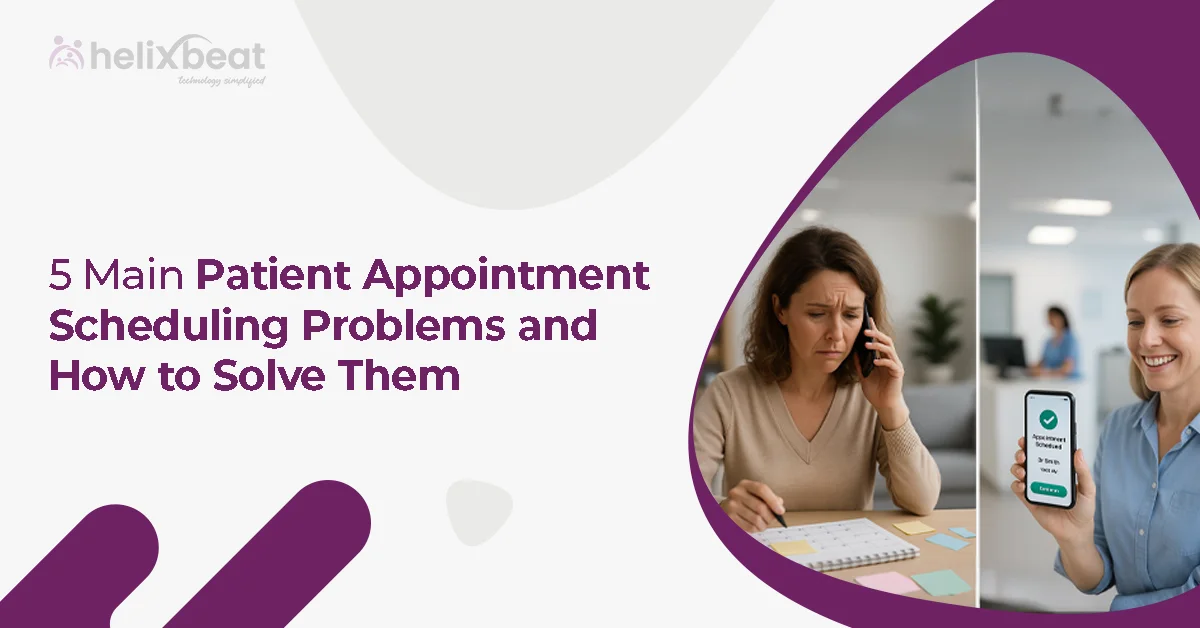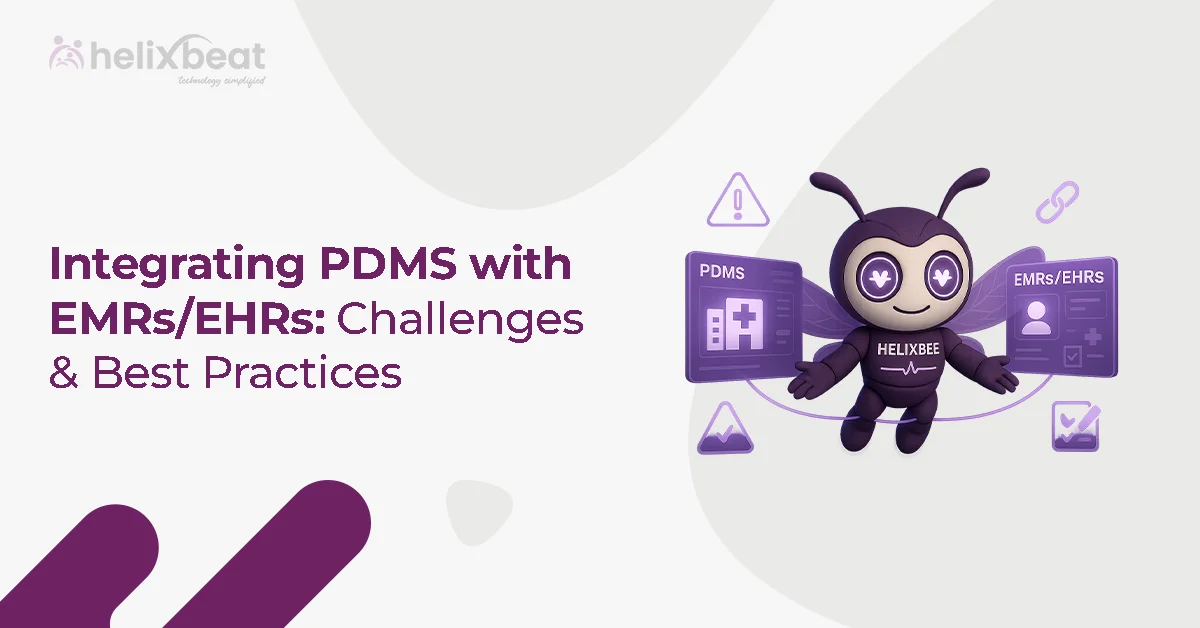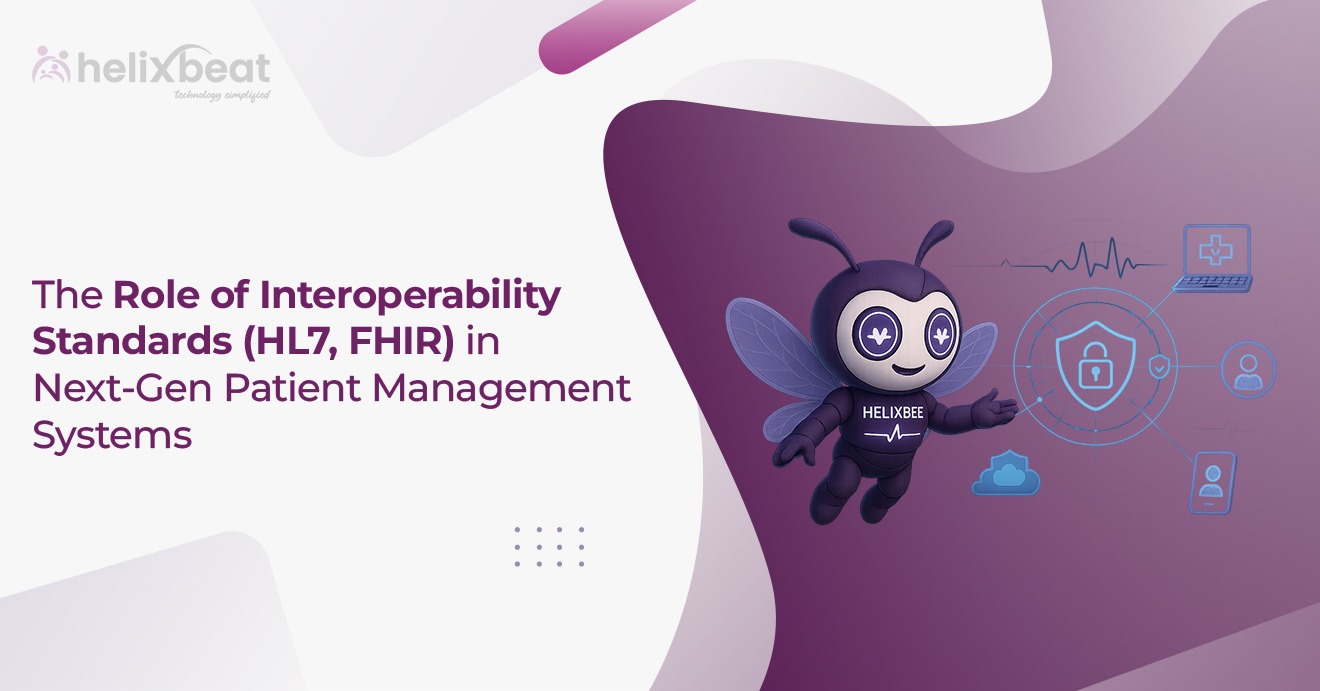Table of Contents
Are you struggling to keep up with your patient appointment schedules?
Appointment scheduling can often be a daunting task for healthcare providers. According to the Journal of Medical Practice Management, 30% of appointments are missed due to poor scheduling practices, leading to wasted resources, reduced revenue, and lower patient satisfaction.
A patient management app can simplify and automate the scheduling process, reducing errors and improving the patient experience. By managing their schedules efficiently, healthcare providers can optimize time, minimize no-shows, and improve patient care.
You can streamline your operations with the right solution, enhancing efficiency and patient outcomes. Further in the blog you will come across the 5 problems and solutions.
(CTA: Start Streamlining Your Appointment Scheduling with Helixbeat)

Problem 1: High No-Show Rates
No-shows are a significant hurdle for healthcare providers, leading to lost revenue and wasted time. Missed appointments can disrupt patient flow, decrease operational efficiency, and affect practice profitability.
- No-shows result in valuable time being lost, decreased revenue, and resources being underused.
- When appointments are missed, it disrupts the planned schedule and hampers the overall efficiency of patient care.
- Empty appointment slots could have been allocated to other patients, which leads to operational inefficiencies.
- No-shows can harm the practice’s reputation and create frustration among both staff and patients.
Solution
- Automated reminders through email or SMS help minimize the likelihood of patients missing their appointments, ensuring they are more informed and prepared.
- A patient management application sends prompt notifications to patients, enhancing their attendance rates and keeping them engaged with their healthcare.
- Enhances resource utilization by maximizing revenue potential and elevating patient satisfaction, leading to more effective practice.
- Prevents scheduling conflicts, ensuring smoother operations and improved workflow.
(CTA: Reduce No-Shows with Automated Appointment Reminders)
Problem 2: Overbooked Schedules
- Overbooking results in lengthy delays for patients, leading to frustration, dissatisfaction and long wait times.
- Crowded schedules burden healthcare teams and staff, hindering quality care.
- Poor tracking can lead to unintentional overbooking, disrupting clinic operations.
- An overloaded schedule makes patients feel rushed and undervalued.
Solution
- Overbooking causes long delays, leading to patient frustration.
- Crowded schedules burden healthcare teams, hindering quality care.
- Poor tracking can lead to unintentional overbooking, disrupting clinic operations.
- An overloaded schedule makes patients feel rushed and undervalued.
Problem 3: Inefficient Communication with Patients
- Relying on phone calls or emails can take too long, leading to missed chances for connecting with patients effectively.
- Delayed communication about appointments can frustrate patients and damage their trust in their healthcare provider.
- When patients don’t get timely updates or reminders, they are more likely to miss their appointments, wasting both time and resources.
- Patients often find it hard to remember appointment details like time and location without good communication tools.
Solution
- Enables real-time chat between providers and patients.
- Important info reaches patients instantly.
- Sends appointment confirmations automatically.
- Notifies patients via SMS, email, or app.
- Shares updates on time, location, or doctor.
- Automates scheduling to reduce mistakes.
- Keeps appointment details updated.
Problem 4: Manual Scheduling Errors
- Relying on manual appointment booking places a heavy burden on human oversight, which can lead to errors such as typos.
- There is a risk of overlapping appointment slots, where two patients may be scheduled for the same time, particularly during peak hours. This creates confusion at the front desk.
- Key information, such as patient contact details, might be overlooked or missed entirely, making it challenging to conduct follow-ups and send reminders.
- Changes or cancellations to appointments often aren’t updated promptly, which can result in gaps in the schedule or patients arriving at incorrect times.
- A lack of centralized scheduling leads to miscommunication and inconsistency between multiple team members.
Solution
- A digital scheduling system automatically validates appointment slots in real time, reducing chances of double bookings.
- It flags any conflicts immediately, allowing staff to fix issues before they affect the schedule.
- Patient profiles are stored with contact information, appointment history, and preferences, helping staff make accurate bookings quickly.
- Automatic updates are reflected across all departments, so everyone has access to the latest schedule in real time.
- It simplifies cancellations and rescheduling, allowing patients or staff to make changes easily without causing mix-ups.
Problem 5: Lack of Integration with Existing Systems
- Many appointments scheduling tools function in isolation, making it difficult for staff to coordinate with other systems like EHRs, lab reports, and billing software.
- Staff often must manually copy patient data between platforms, which not only wastes time but also increases the likelihood of data entry errors.
- When systems aren’t connected, appointment changes or cancellations may not reflect across all departments, leading to confusion and missed communications.
- Lack of integration can result in patients being asked for the same information multiple times, negatively affecting their experience and trust in the care process.
- Without a unified view of patient information, healthcare providers may miss important medical history or details that affect care planning and outcomes.
Solution
- Choose a scheduling tool that integrates with your EHRs, billing systems, and communication platforms to create a connected workflow.
- Appointment updates sync across all systems automatically, reducing manual work and keeping teams aligned.
- Integration ensures secure sharing of patient data, improving billing accuracy and care coordination.
- Staff benefit from smoother processes and can spend more time on patient care.
- Patients experience better communication, fewer repeated questions, and more coordinated services.
How a Patient Management App Can Solve These Problems
Ever wondered how much time and effort your team could save with the right digital tools?
A modern patient management app can eliminate many of the issues caused by manual scheduling, disconnected systems, and communication delays. Instead of juggling multiple platforms or dealing with no-shows and errors, healthcare providers can automate and streamline the entire appointment process.
Reduces no-shows with automated confirmations
- Sends SMS, email, and app notifications to remind patients.
- Allows easy confirmations, cancellations, or rescheduling.
Avoids overbooking by managing real-time capacity
- Displays real-time availability of doctors and resources.
- Adds buffer times and accounts for emergency bookings.
Enhances communication via multiple channels
- Enables two-way messaging, alerts, and appointment updates.
- Centralizes communication across SMS, email, and app.
Eliminates manual errors through automation
- Auto-fills patient info and syncs calendars.
- Prevents double bookings and time-slot conflicts.
Integrates smoothly with EHRs, billing, and more
- Connects with Electronic Health Records, billing, and CRM.
- Updates reflected instantly across systems—no duplicate data entry.
To Sum It Up
Patient appointment scheduling issues can harm both operational efficiency and patient trust. Challenges like no-shows, overbooked slots, communication breakdowns, and system disconnects aren’t just inconveniences—they directly impact your team’s productivity and patient satisfaction.
Solving these problems goes beyond quick fixes or manual effort. It requires a smart, unified, and tech-driven approach.
By adopting a comprehensive patient management app, healthcare providers can:
- Reduce errors
- Improve patient engagement
- Save valuable staff time
- Boost overall clinic performance
Ultimately, it leads to smoother workflows, happier patients, and more organized practice, exactly what every modern healthcare setup needs.
FAQs
What is the best patient management app for appointment scheduling?
Helixbeat offers a comprehensive patient management app designed to streamline appointment scheduling, reduce no-shows, and enhance communication with patients.
How can a patient management app reduce scheduling errors?
By automating the scheduling process, a patient management app eliminates human errors, such as double bookings or missed appointments.
How can I prevent overbooking using patient scheduling software?
A patient management app provides real-time visibility into your schedule, helping you avoid overbooking and ensuring a smooth flow of appointments.
How does a patient management app improve patient communication?
The app allows automated reminders and real-time messaging, ensuring both the healthcare provider and patient are always informed about appointments.
Is a patient management app suitable for small practices?
Yes, Helixbeat’s patient management app is scalable and suitable for practices of any size, offering solutions tailored to small, medium, and large healthcare providers.
Can a patient management app integrate with other healthcare systems?
Helixbeat’s app integrates seamlessly with existing systems like EHR, CRM, and billing software, ensuring smooth data flow across your practice.
Does a patient management app improve patient retention?
Yes, by improving the patient experience with better scheduling, communication, and follow-ups, patient retention increases significantly.
How does a patient management app help with workflow efficiency?
Helixbeat’s patient management app reduces administrative workload, allowing staff to focus on patient care and improving overall workflow efficiency.
What features should I look for in a patient management app?
Look for features like appointment scheduling, automated reminders, patient communication tools, and seamless integration with other healthcare systems.
How long does it take to implement a patient management app?
The implementation time depends on your practice’s size and system requirements, but Helixbeat offers quick, easy setup with dedicated support throughout the process.














